Related Research Articles
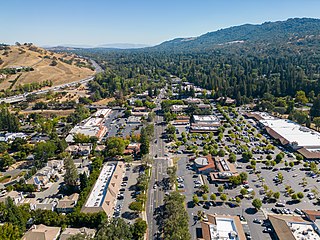
Alamo is an unincorporated community and census-designated place (CDP) in Contra Costa County, California, in the United States. It is a suburb located in the San Francisco Bay Area's East Bay region, approximately 28 miles (45 km) east of San Francisco. Alamo is equidistant from the city of Walnut Creek and the incorporated town of Danville. As of the 2020 census, the population was 15,314.

Lafayette is a city in Contra Costa County, California, United States. As of 2020, the city's population was 25,391. It was named after the Marquis de Lafayette, a French military officer of the American Revolutionary War.
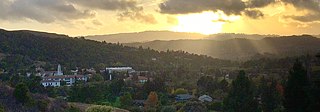
Moraga is a town in Contra Costa County, California, in the San Francisco Bay Area. The town is named in honor of Joaquín Moraga, member of the famed Californio family. As of 2020, Moraga had a total population of 16,870 people. Moraga is the home of Saint Mary's College of California.

Walnut Creek is a city in Contra Costa County, California, United States, located in the East Bay region of the San Francisco Bay Area, about 16 miles east of the city of Oakland. Walnut Creek has a total population of 70,127 per the 2020 census, is located at the junction of the highways from Sacramento and San Jose (I-680) and San Francisco/Oakland (SR-24), and is accessible by BART. The city shares its borders with Clayton, Lafayette, Alamo, Pleasant Hill, and Concord.

The Coast Miwok are an Indigenous people of California that were the second-largest tribe of the Miwok people. Coast Miwok inhabited the general area of modern Marin County and southern Sonoma County in Northern California, from the Golden Gate north to Duncans Point and eastward to Sonoma Creek. Coast Miwok included the Bodega Bay Miwok, or Olamentko (Olamentke), from authenticated Miwok villages around Bodega Bay, the Marin Miwok, or Hookooeko (Huukuiko), and Southern Sonoma Miwok, or Lekahtewutko (Lekatuit). While they did not have an overarching name for themselves, the Coast Miwok word for people, Micha-ko, was suggested by A. L. Kroeber as a possible endonym, keeping with a common practice among tribal groups and the ethnographers studying them in the early 20th Century and with the term Miwok itself, which is the Central Sierra Miwok word for people.
The Bay Miwok are a cultural and linguistic group of Miwok, a Native American people in Northern California who live in Contra Costa County. They joined the Franciscan mission system during the early nineteenth century, suffered a devastating population decline, and lost their language as they intermarried with other native California ethnic groups and learned the Spanish language.

The Tri-Valley area is grouping of three valleys in the East Bay region of California's Bay Area. The three valleys are Amador Valley, San Ramon Valley, and Livermore Valley. The Tri-Valley encompasses the cities of Dublin, Livermore, Pleasanton and San Ramon, the town of Danville and the CDPs of Alamo, Blackhawk and Diablo. The area is known for its Mediterranean climate, wineries, and nature. It is primarily suburban in character. The United States Census Bureau defines an urban area centered in the cities of Livermore, Pleasanton, and Dublin with a 2020 population of 240,381, ranked 167th in the United States in terms of population. The total population of the area is estimated to be 361,000. It offers more affordable living accommodations than the cities of San Francisco and San Jose.
Lamorinda is an area within Contra Costa County, California in the United States. The name is a portmanteau from the names of the three cities that make up the region: Lafayette, Moraga and Orinda.
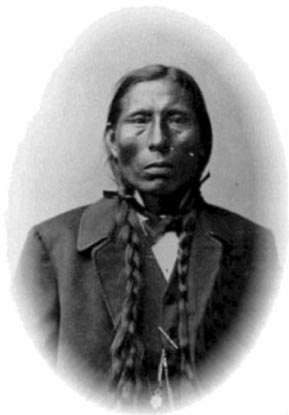
The Suisunes were a Patwin tribe of Wintun people, originating in the Suisun Bay and Suisun Marsh regions of Solano County in Northern California. Their traditional homelands stretched between what is now Suisun City, Vacaville and Putah Creek around 200 years ago. The Suisunes' main village, Yulyul, is believed to be where Rockville, California is located today. Father Abella, visitor to the tribe in 1811, indicated they resided in the present location of Fairfield, north of the Suisun Bay. One of the Suisunes' primary food sources was acorns. Their diet also included fish as well as miner's lettuce. Their huts were conical wikiups made of rushes or tule thatch.
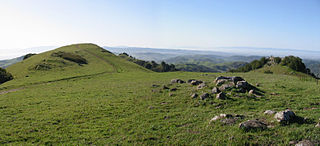
Las Trampas Regional Wilderness is a 5,342-acre (21.62 km2) regional park located in Alameda and Contra Costa counties in Northern California. The nearest city is Danville, California. Las Trampas is Spanish for the traps, or the snares. The park belongs to the East Bay Regional Park District (EBRPD).
Castle Hill is a census-designated place in Contra Costa County, California. Castle Hill sits at an elevation of 302 feet (92 m). The 2010 United States census reported Castle Hill's population was 1,299.

The Walnut Creek mainstem is a 12.3-mile-long (19.8-kilometer) northward-flowing stream in northern California. The Walnut Creek watershed lies in central Contra Costa County, California and drains the west side of Mount Diablo and the east side of the East Bay Hills. The Walnut Creek mainstem is now mostly a concrete or earthen flood control channel until it reaches Pacheco Creek on its way to Suisun Bay. Walnut Creek was named for the abundant native Northern California walnut trees which lined its banks historically. The city of Walnut Creek, California was named for the creek when its post office was established in the 1860s.

Las Trampas Creek is a 12.37 mile long north-east flowing stream in Contra Costa County, California. Its watershed comprises an area of 17,238 acres. It's mean daily flow is approximately 15.4 cfs.

Grizzly Creek is a 3.2-mile-long northwest-flowing perennial stream in Contra Costa County, California. It is a major tributary of Las Trampas Creek, which is part of the larger Walnut Creek watershed, which in turn drains into Suisun Bay.

Las Trampas Peak is a 1,827 ft (557 m) peak in the Inner Coast Ranges in western Contra Costa County, California, in the San Francisco Bay Area.

Rocky Ridge is a 2,020 ft (620 m) ridge in the Inner Coast Ranges in western Contra Costa County, California, in the San Francisco Bay Area. Being the second-highest mountain in the county, it is visible from much of the surrounding area. The ridge is a very prominent feature in the geography of the towns of Lafayette, Moraga and Orinda, California.
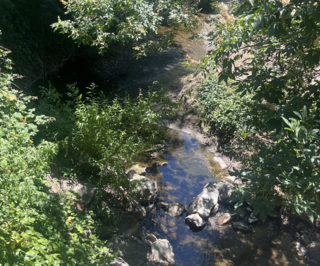
Lafayette Creek is a 3.78 mi (6.08 km) long creek in Contra Costa County, California in the San Francisco Bay Area. It is a tributary of Las Trampas Creek.

Tice Creek is a minor creek in Contra Costa County, California in the San Francisco Bay Area. It is approximately 4.1 miles (6.6 km) long. It is a tributary of Las Trampas Creek, which itself is a major tributary to Walnut Creek which in turn drains into Suisun Bay. The name comes from the surname of a settler family who settled in the Tice valley.

Buckhorn Creek is a 2.1 mile long creek in Contra Costa County, California, in the San Francisco Bay Area. It gets its name from the Buckhorn family who settled on the creek in the late 19th century.
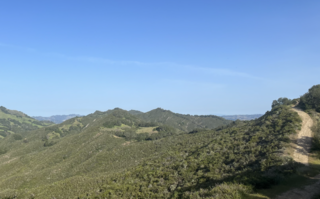
Las Trampas Ridge is an 1,827 ft ridge in western Contra Costa County, California, in the San Francisco Bay Area. It comprises the western side of the San Ramon Valley.
References
- 1 2 3 Erwin G. Gudde; William Bright (May 10, 2004). California Place Names: The Origin and Etymology of Current Geographical Names. University of California Press. p. 3. ISBN 978-0-520-24217-3 . Retrieved January 20, 2012.
- ↑ "The Saclan Indians". Historic Moraga California. Retrieved January 20, 2012.
- ↑ "Museum of the San Ramon Valley". museumsrv.org. Archived from the original on June 7, 2023. Retrieved June 7, 2023.
- 1 2 Google Maps Retrieved December 16, 2023
- ↑ Tribal History Retrieved May 18, 2013